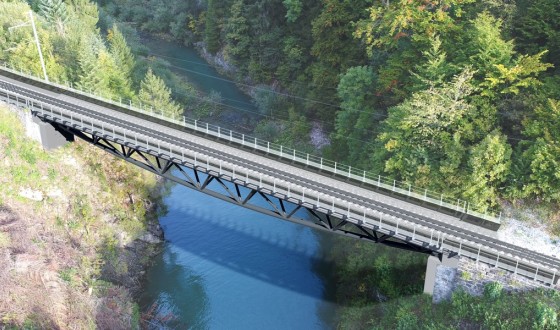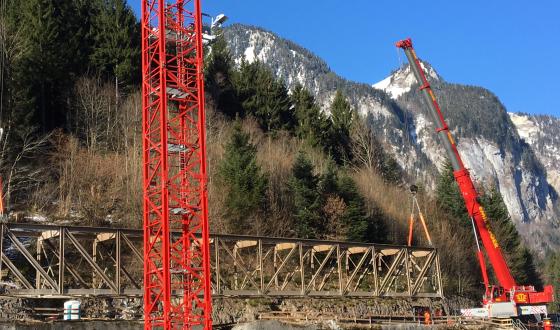Swiss Railway Bridge supported by MSH Sections
Swiss Railway Bridge supported by MSH Sections
19/04/2018 – Industry / Germany
For almost 114 years, the Swiss narrow-gauge railway line has passed a small iron bridge on its picturesque route from Montreux to Zweisimmen in the Bernese Oberland.
MOB, the Swiss company running the Montreux Oberland Railway Line, opted for a comprehensive renovation in 2016, which had to meet several special demands. Representing a remarkable constructive exception among the many masonry bridges along the route, the renovated bridge had to ensure a design similar to the old bridge. Apart from the building itself, the project posed complex demands on the construction site logistics, as the main construction work – removal of the old construction and assembly of the new bridge – had to be carried out completely within the regular ten weeks gap of the train timetable.
Remarkably slim design
T Ingénierie SA (CH), the company who did the main planning and construction work in the project, also directed all processes of the Lanciau Bridge renovation. The Geneva based company had designed a slim arched steel girder that elegantly supports the also newly installed track bed. Following inspection and repair work of the existing masonry abutments, the new structure could be placed onto the abutments without further modifications in a time-saving and economical way. The design of all steel and concrete construction elements had undergone static testing by Monod-Piguet + Associes IC SA, Lausanne (CH), while special fatigue checks and testing of the steel construction was carried out by KoRoh GmbH, Karlsruhe (D).
Short-term production and delivery – fast assembly
The remarkably slim design of the girder mostly relies on the bent lower belt of the construction, which is made of circular hot-rolled seamless MSH sections with impressive outer dimensions of e.g 559 mm and 50 mm wall thickness. The MSH sections were manufactured applying Vallourec’s pilger rolling process in the group’s Düsseldorf-Rath facilities. Vallourec took up the challenge of an extraordinary short-term production and delivery time basis with barely 8 weeks from order to delivery. The MSH sections were delivered directly to Sottas SA Constructions métalliques (CH) who carried out all steel construction works including the bending of the huge tubes for the lower belt.


Situated right at the point where the river Sarine flows into the Lac du Vernex and close to the station of Rossinière, the "Lanciau Bridge" marked the scenic beauty with its filigree riveted steel framework construction. However, the small bridge had become technically outdated in recent years.
Profiling the tubes
Challenging technical requirements like Execution class 4 (EN1090) resulted in involvement of ZIS Industrietechnik GmbH, a specialist in 3D cutting of tubes and rectangular hollow sections. Fulfilling technical and formal requirements, based on the 3D design model the required 3D contours had been manufactured. Upfront delivery a detailed model of the resulting contours was sent to the steel construction company. Together with an accurate oxygen cutting of the 3D contours an efficient assembly and welding of the tubes was granted.
Production of the Bridge
The sole task of putting all parts fitting together and assemble on site has been executed by Sottas SA. Well experienced in steel construction this project was the first composite train bridge structure in companies history. To meet the tight time schedule with shortest downtimes for the railway line the structure was welded on the shopfloor and afterwards sent by truck to the construction site. Beside the steel construction the deck part was prepared with precast concrete trough elements to reduce the erection time on site.
Finally the new bridge will be in place just 18 weeks after the beginning of the assembly works in the workshop of Sottas SA.
Design by T Ingénierie SA supported by KOROH GmbH granted quick progress. This project is a perfect example for hand in hand cooperation between steel manufacturer, profiling, design and final execution.
Deconstruction of the old riveted steel structures from 1904 was carried out by a 32 to rotating tower crane, which had to be assembled on site, plus a mobile crane unit.



